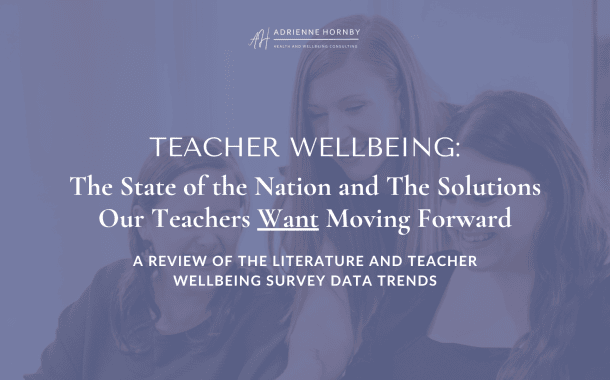
Turning Insights into Action: Closing the Feedback Loop After Surveying Your Staff
Gathering feedback from staff using a Staff Wellbeing Survey is only the first step of an effective strategy to improve wellbeing and culture. It’s what we do with that information that really makes all the difference. “Closing the feedback loop” involves acknowledging the feedback received and, most importantly, responding to it through transparent communication and strategic actions.
Too often in schools, I see surveys being distributed with no follow-through:
- Feedback is collected but never acknowledged or reviewed
- Suggestions pile up, but nothing seems to change
- Leaders do act on feedback, but staff aren’t aware of the connection to their input
- There’s little transparency about why some feedback can’t be actioned, leading to frustration from staff
As a result, staff begin to feel like their voices don’t matter, and feedback becomes just another “box to tick.” Without transparency and strategic communication, even the best intentions can lead to missed opportunities for meaningful change.
This article covers:
- The importance of capturing staff and teacher wellbeing feedback
- The pitfalls of neglecting feedback
- Common challenges and mistakes schools make when gathering and reviewing staff wellbeing feedback
- The value of closing the feedback loop
- Tips and strategies for effectively keeping staff updated on the outcomes of their input
Let’s ensure that feedback doesn’t end up sitting in a desk pile for months on end but that it’s valued, acted on, and used as a tool to strengthen your school’s culture.
The Importance of Capturing Staff Feedback About Wellbeing
Capturing staff feedback through a school scan process allows school leaders to identify staff challenges and needs regarding their workplace wellbeing.
A comprehensive approach to assessing staff and teacher wellbeing should include:
- Anonymous staff wellbeing survey
- Review of other collected school data
- One-on-one interviews
- Focus groups
- Observational data
- Performance metrics
By using a range of data collection methods, schools can gain a more holistic view of staff and teacher wellbeing and school culture. This diverse approach ensures that various perspectives are captured and reduces the risk of overlooking important issues. This information can then be translated into effective responses and strategic actions.
The Pitfall of Neglecting Feedback
One of the most common mistakes schools make after conducting wellbeing surveys is letting the feedback get lost in the shuffle. When staff take the time to provide honest and thoughtful responses, it’s crucial that their input doesn’t disappear into a void. Failing to report back to staff can lead to:
- Decreased trust in leadership
- Reduced participation in future surveys
- A sense that staff opinions don’t matter
- Missed opportunities for meaningful change
Common Challenges & Mistakes Schools Make When Gathering and Reviewing Feedback
When schools gather feedback from staff, they often face challenges in “closing the feedback loop,” resulting in staff frustration and a sense that their voices go unheard. Here are common pitfalls schools encounter in gathering and responding to staff feedback, along with ideas to improve the process:
Compounding surveys with little action
- Mistake: Schools often conduct multiple surveys without clear communication or follow-up, which can lead to “survey fatigue” and a perception that feedback is requested simply as a checkbox exercise.
- Solution: Ensure each survey is necessary. Communicate upfront how each survey builds on previous insights and contributes to the school’s broader goals.
Captured feedback with no follow-up or updates
- Mistake: Schools frequently gather staff feedback but fail to communicate back to staff on any actions, progress, or challenges, which can cause staff to feel unheard and unvalued.
- Solution: After gathering feedback, promptly provide an overview of key findings and outline initial next steps. Set regular update intervals to maintain transparency, even if actions are still being developed.
Inaction on feedback and staff perception of “empty promises”
- Mistake: When staff feel that feedback is ignored or results in no concrete changes, it leads to skepticism, disengagement, and eroded trust in leadership.
- Solution: Prioritise visible actions on feedback, even small ones, to demonstrate responsiveness. When actions require time or resources, explain the timeline and any limitations openly to manage expectations.
Lack of transparency on feedback usage and decision-making
- Mistake: Schools often fail to clarify how feedback will be used, or there’s little visibility into how decisions are made, which can create doubt around the purpose of feedback initiatives.
- Solution: Before launching a survey, clearly outline the purpose, intended outcomes, and how feedback will guide decision-making. Afterward, offer detailed explanations on which suggestions will be actioned, postponed, or set aside and why.
No communication on constraints or “why things can’t be actioned”
- Mistake: When staff don’t understand why certain suggestions can’t be implemented, it leads to misinterpretations about leadership’s commitment or resources.
- Solution: Address openly why some suggestions may not be feasible due to budget, resources, context, or other constraints. Providing clear reasons builds understanding and helps to prevent staff seeing your attempts as “lip service.”.
Leadership takes action but fails to connect changes back to feedback
- Mistake: Leaders may implement changes based on feedback but fail to communicate this to staff, causing a disconnect where staff don’t realise their input had an impact.
- Solution: Explicitly link improvements or changes back to the feedback received. This reinforces that staff voices are heard and valued, strengthening trust and participation in future feedback opportunities.
The Value of Closing the Feedback Loop
Closing the feedback loop means more than just acknowledging that a survey has been completed. It involves a thorough review of the data, identification of key themes, and a clear response to the feedback received.
Here’s why this process is so important:
- Demonstrates respect: It shows staff that their opinions are valued and taken seriously.
- Builds trust: Transparent communication about survey results fosters trust between staff and leadership.
- Encourages future participation: When staff see that their feedback leads to action, they’re more likely to engage in future surveys.
- Facilitates meaningful change: By addressing key themes and suggestions, schools can implement targeted improvements.
Best Practices and Strategies for Closing the Feedback Loop
To effectively close the feedback loop, consider the following strategies:
- Respond in a timely manner: Don’t let too much time pass between staff providing feedback and your response. Aim to provide initial feedback within a few weeks of the provision of feedback or when you review results.
- Share findings transparently: Share a summary with all staff, highlighting both positive findings and areas for improvement.
- Address key themes: Identify recurring suggestions or concerns in the data and provide a clear response to each. This doesn’t mean you have to act on every suggestion, but you should acknowledge them and explain your reasoning.
- Develop an action plan: Develop and share a concrete plan for addressing the most pressing issues identified in the survey.
- Provide regular updates: Keep staff informed about progress on initiatives stemming from their feedback. This could be through monthly emails, staff meetings, or a dedicated section on the school’s intranet.
- Make outcomes visual: Even with the best communication, some of our communication can end up lost in the void. Visually display findings and outcomes for staff to refer to reguarly as a prompt.
- Keep the conversation going: Encourage ongoing conversations about wellbeing and school culture. The feedback loop should be seen as a continuous process, not a one-time event.
Download our free resource: Tips for Communicating Decisions to Staff After Consultation.
Conclusion
By consistently closing the feedback loop, schools can create a culture of open communication and continuous improvement. This leads to increased staff engagement and morale, better retention rates, improved school culture and enhanced student outcomes.
Remember, the goal of gathering staff feedback is not just to collect data but to use that data to create positive change. Surveying staff about their wellbeing is an important first step, but it’s the follow-through that truly makes a difference. By closing the feedback loop, you demonstrate your commitment to your staff’s wellbeing and the overall success of your school, turning valuable insights into meaningful action.
Take the Next Step with our Staff Wellbeing Surveys
If you’re ready to turn feedback into meaningful action, our Staff Wellbeing Survey is your ideal starting point. With 80+ questions across five sections, you’ll gain insights into your staff’s wellbeing, their burnout risk, the stressors impacting them the most, and perceptions of morale, engagement, and school and leadership processes.
When you choose the Survey + Data Analysis & Recommendations package, you’ll also receive:
- In-depth data analysis that identifies key themes and trends
- Actionable recommendations tailored to your school’s unique needs
- School comparison report comparing your school’s data to other similar schools in the nation so you can see where you stack up
With all this at your fingertips, you’ll feel empowered to take strategic next steps that will lead to the culture transformation your school is after.
Explore our Staff Wellbeing Survey Packages here.
If you’re ready to take it one step further, our Well-Led Schools Partnership Program gets you from point A to B, guiding you through the process of keeping staff engaged and informed as you undertake school-wide change. This program supports schools in continuously closing the feedback loop through regular updates, transparent communication, and strategic actions—all crucial for building trust and driving change.
From the blog
Optimising School Workload with Practical Tips and Resources from the AITSL Workload Reduction Toolkit
Ask any teacher or school leader about their biggest source of stress, and you’ll likely hear the same answer: workload. Evidence indicates that school leaders…
Teacher Wellbeing: The State of the Nation and The Solutions Our Teachers Want Moving Forward
Teacher wellbeing is not just a personal issue; it’s a professional necessity. It’s closely tied to educator success and student outcomes, and a lack of…
Staff Morale in Schools: How Culture, Leadership and Staff Drive Engagement
If you’ve been leading or working in a school over the past few years, you’ve probably felt it – the subtle, steady dip in energy,…



